The last day of September, in Ireland. The rain has washed in, all is grey and there is a nip in the air, woollen hats needed on the beach yesterday afternoon, a cold wind from the Northeast at our backs on the way home. My days are beechwood and cedar, rustling oak and tumbling honeysuckle, there is salt in the curls of my hair and sand in all our shoes, not even my boy’s school shoes have escaped. At night the sound of the sea moves through the rooms and yesterday someone nearby had their fire lit. Woodsmoke mingling deliciously with the salty air on our walk down to the beach, where we watched seals swimming up close in the bay. My boy, still convinced I was a Selkie before he was born, held on to me so I wouldn’t go into the sea with them. I was sorely tempted but instead walked with my feet in the water whilst he played on the sand. On Saturday I picked a glut of dark, ripe elderberries, I found growing amongst oak and hawthorn, to make immune boosting syrup to tide us through the cold to come. We are slowly finding our balance in this new place. And there is magic everywhere we look.
Two years ago today, I packed my then near-three-year-old into the car and drove North, in a storm so severe the town helter-skelter ended up in the harbour. The rain came down in sheets so heavy I could barely see the road. But we had an appointment I was determined to keep. It was a house viewing, another one; I’d lost count how many we’d viewed by then. Too many. Years of it. Years of disappointments, chains breaking down, sellers reneging, mould-ridden houses with astronomical prices, concrete “gardens” and “views” directly into other people’s windows, but “if you stand on your tiptoes just here you can see the mountain!”. We’d lost out on a nursery place due to a seller refusing to progress the sale (almost three years later he’s still “selling”). And I’d had my heart broken too many times to count, my romanticism dreaming up lives in houses which always fell through.
So that day, in the storm, my heart was guarded, and I had a critical eye. The day was so dark all the lights were on, but there was nothing cosy about it, it was colder inside than out because it had already been uninhabited for months. There was a dirty bathroom which opened directly into the kitchen. The wooden extension was visibly rotten and the wiring was obviously dodgy. Parking was an issue and I could smell damp. But it had good bones, it was in a great location, with real views across the bay, a big oak tree and a private garden and it felt good, comforting somehow. I’ve since talked to others who’d viewed it too and they’ve all said the same thing; too much work, but it’s a lovely feeling house. And so, the estate agent and I talked, more openly and honestly than we had in all the years before that. I was weary and he could see it. He talked to me as a single mother, not a potential client. He told me how to negotiate for it, how to cover all I needed to. He told me to wait.
Of course, it was our house, the one we are still renovating. Two years ago, I saw it for the first time, a long ten months of negotiation on the ridiculous price later I had the keys and by October’s full moon we will be moved in. Life rarely goes to plan, but sometimes, if you’re very lucky, it works out as it’s meant to. We’re almost home.
With the moves (the big one still to go!) and renovations we are well off our moons here, and I am playing catch up. Today’s post is September’s Na Scéalta, the tales, in which I retell stories rooted in the local landscape. October’s Writing Down the Weeds on Elder will follow at the weekend when the new moon becomes visible in our skies. Be sure to subscribe to get it directly in your inbox when it posts.
Here, even in town, the landscape is a dominant feature of our days. Nestled at the foot of a mountain, where the glens meet the sea, the landscape rises above us. The mountain to the South and then, rising sharply from the sea the headland to the Northeast. It is this headland I will tell stories of today.
Benmore (the great headland) is indeed one of the great headlands of the entire island and is a stunning sight in any weather. It overlooks Rathlin island, Scotland’s Mull of Kintyre and the sea of Moyle, where the Children of Lir are said to have spent five hundred years adrift on its stormy waters. Benmore is perhaps recognisable to Game of Thrones fans as Dragonstone, but this steep sea cliff is known best by its folkloric name, Fairhead.
Once, so it is said, on Rathlin, just offshore, there was a beautiful, yellow haired young woman. Two young men were so enamoured with her that they fought. The understanding was that the winner would claim her hand in marriage. However, with his dying breath the looser whispered instructions to his servant. The servant, following his master’s orders danced with the girl on the sea cliffs beneath the castle. And in vengeance, he danced her to her death right off the edge. Her body washed up across the sound at the foot of the Benmore and it has been known since for her yellow hair.
The basalt cliff face falls sheer for almost two hundred meters and hosts an annual climbing meet. The top of the headland has several loughs and has been inhabited for thousands of years as evidenced by remains of a crannog, a cairn, a megalithic chamber and the more recent remains of a Norman fort.
One lough atop Fairhead, suitably named Lough Dubh, translating as the dark or the black lough, is said to be home to one of the most fearsome of our folkloric beasts, the each-uisce. Similar to a kelpie, but far more dangerous, this water horse is a shapeshifter which inhabits the sea or loughs throughout Irish and Scottish folklore. It is said to appear as a beautiful horse, a fine bird or handsome man, all in a bid to ensnare a human victim and pull them to a watery grave, where it devours all but the liver. A local tale tells of a woman who gathered dulse (edible seaweed) at the foot of the cliffs. One evening she encountered a handsome man with green water weeds strewn through his hair. He walked back up to the headland with her and told her he had lived under the dark lough there for thousands of years. Yet it was only when sleeping beside him that she saw his hoven feet and understanding the danger she made off with her life. When the water-spirit discovered his prey was gone he neighed so loudly it was heard across town.
Routes to the top are numerous, including a roadway which leads to a national trust carpark, but the most ominous must be the Grey Man’s path, which leads from the foot of the cliffs at their western side to the top and is said to be haunted by a spectral figure, An Fear Liath, the Grey Man, who leads hikers astray off the cliffs into the grey sea mists that suddenly swirl in. He has two other sites named for him further east along the coastline but no matter where he is seen a sighting of him portends disaster, often in the form of a violent storm. Eyewitness accounts describe him as a human figure appearing from the mists, his long coat trailing into the grey. This spirit has been linked to the Irish storm god Fir-Li, the folkloric devil and to the myth of a holy man who in life spent his time on the headland in prayer. However, given the links of the path and Lough Dubh above with the folklore of the Sidhe each-uisce, I am more inclined to believe the former connection than the latter two. You can read my fictional use of this lore entwined with other folktales of the surrounding area in the first of this series here.
East of the headland is the townland of Ballyucan, said to have been home to five giants. And a huge stone nearby is named for our renowned north coast giant Fionn Mac Cumhaill.
West of Fairhead, at the end of the beach there is a rocky outcrop now known as Pans Rock, but originally named Carraig Uisnigh (Rock of the Sons of Uisneach). For it was the landing place of the beautiful and doomed Deirdre and her lover’s brother as they fled back to Ireland from Scotland where a lustful king had attempted to kill her lover Naoise and his two brothers in order to claim her for himself. The tale does not end well for the lovers as Naoise is murdered by a jealous Irish king and the grieving and abused Deirdre takes her own life. There is now a carving of a face in the stone just off these rocks, accessible only by sea and said to be that of Deirdre of the Sorrows, one of the greatest tragedies in Gaelic literature.
Everywhere we look here there is deep history, folklore and mythology. It could take a lifetime to explore it all. Next month I’m hoping to bring you some tales of hauntings from the area and hopefully some new fiction for this project.
Thank you all for sticking with me whilst my posts have been so irregular. Each subscription, comment, note and restack means more to me than I can express.
Thank you Grá agus Saoirse Siobhán
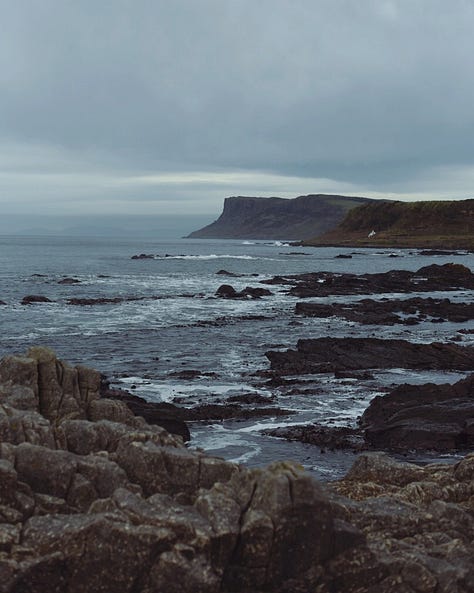

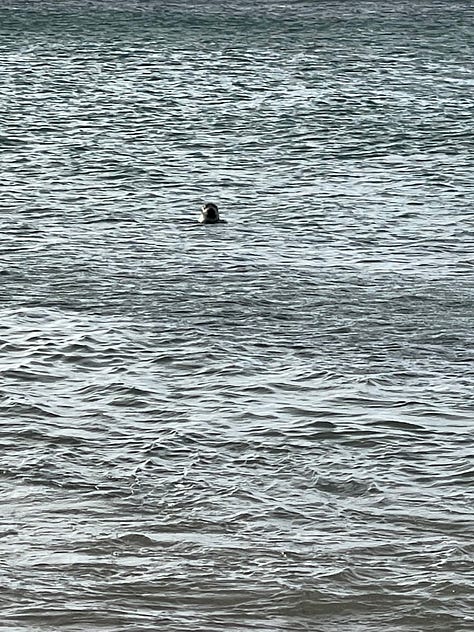
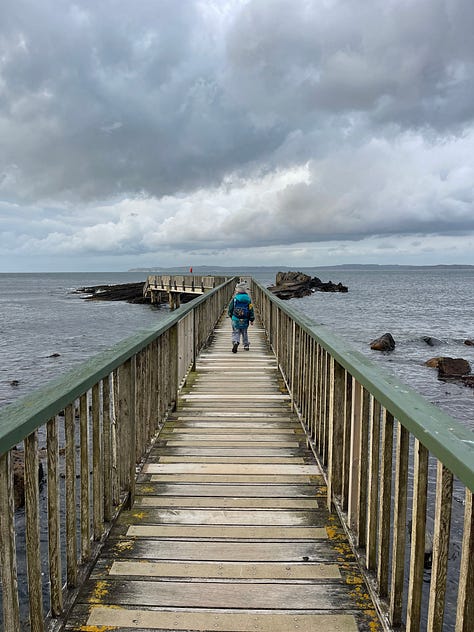
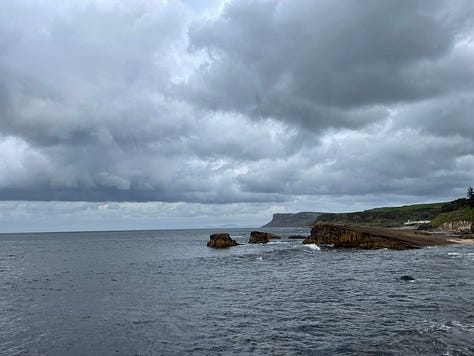
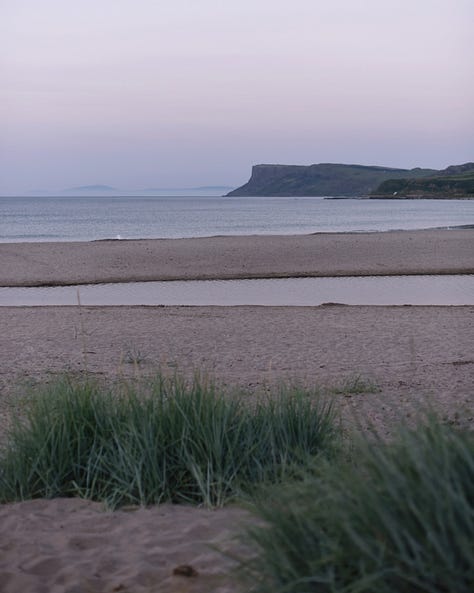

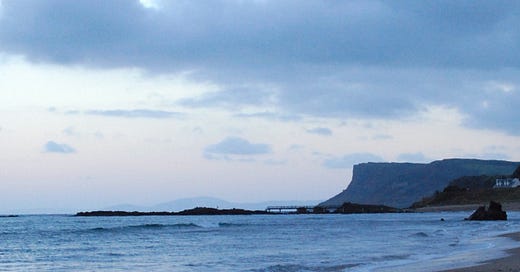





GRMA as always Siobhán 🙏 Is áit dhraíochtúil é, cósta thuaidh an oileáin. Bain sult as é sna séasúir is tanaí seo.
Between your scéalta, and the current program of Scoil Scairte, I feel the land calling me home…albeit further northwest, where countless school holidays were spent at my cousins cottage on Fanad. The summers are but a fleeting memory, but Easter and autumn mid-term breaks are impressed into my body. Living there is a somatic experience first and foremost, so it’s no wonder your recognized that the old house with good bones was choosing you to make it a home again.
Beautiful and so resonate with finding home in places that don't always seem 'the one' on the surface, but really are -- 'good bones' and atmosphere go a long way. Hope the home making there is a wonderful adventure.